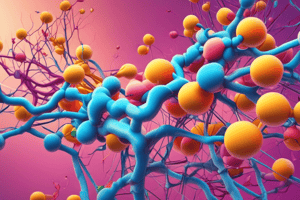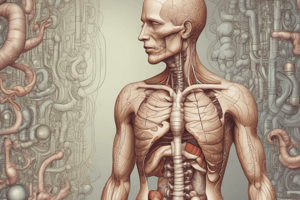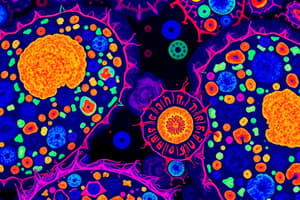Podcast
Questions and Answers
What is the typical number of nucleotide pairs of DNA that a monomer typically binds?
What is the typical number of nucleotide pairs of DNA that a monomer typically binds?
- 3-5
- 6-8 (correct)
- 10-12
- 15-18
How often would a 6 nucleotide sequence occur in dimerization?
How often would a 6 nucleotide sequence occur in dimerization?
- Once every 46 nucleotides (4096) (correct)
- Once every 60 nucleotides (3600)
- Once every 100 nucleotides (10000)
- Once every 30 nucleotides (900)
What are the lengths of enhancers typically range from?
What are the lengths of enhancers typically range from?
- 1-10 bp
- 100-300 bp
- 250-500 bp
- 5-200 bp (correct)
What type of proteins further increase affinity and specificity in dimerization?
What type of proteins further increase affinity and specificity in dimerization?
What is the function of promoters in gene expression?
What is the function of promoters in gene expression?
What are transcription activators and repressors composed of?
What are transcription activators and repressors composed of?
What kind of domains do activation/transactivation domains belong to?
What kind of domains do activation/transactivation domains belong to?
What kind of motif does the bacteriophage 434 repressor have?
What kind of motif does the bacteriophage 434 repressor have?
What is the consensus sequence of DNA response elements that bind to nuclear receptors?
What is the consensus sequence of DNA response elements that bind to nuclear receptors?
Which domain functions as a repression domain in some nuclear receptors in the absence of a ligand?
Which domain functions as a repression domain in some nuclear receptors in the absence of a ligand?
What type of response element does the RXR-VDR heterodimer bind to?
What type of response element does the RXR-VDR heterodimer bind to?
What happens when a hormone binds to the glucocorticoid receptor ligand binding domain?
What happens when a hormone binds to the glucocorticoid receptor ligand binding domain?
What is the function of the activation domain at the N-terminus of nuclear receptors?
What is the function of the activation domain at the N-terminus of nuclear receptors?
Which type of response element do estrogen receptors bind to?
Which type of response element do estrogen receptors bind to?
Where is the receptor-hormone complex retained in the absence of cortisol?
Where is the receptor-hormone complex retained in the absence of cortisol?
What defines the hormone response in heterodimeric nuclear receptors?
What defines the hormone response in heterodimeric nuclear receptors?
Which structural motif is the most common DNA binding motif in human and other mammalian genomes?
Which structural motif is the most common DNA binding motif in human and other mammalian genomes?
Which type of proteins interact with the DNA backbone at adjacent sites in the major groove?
Which type of proteins interact with the DNA backbone at adjacent sites in the major groove?
What type of transcription factors allow for combinatorial possibilities and increase gene-control options?
What type of transcription factors allow for combinatorial possibilities and increase gene-control options?
Which transcription factors bind cooperatively to composite DNA sites?
Which transcription factors bind cooperatively to composite DNA sites?
What does HMGI do to the minor groove of DNA?
What does HMGI do to the minor groove of DNA?
How can TF activity be indirectly regulated?
How can TF activity be indirectly regulated?
Which type of proteins are found in 50 human transcription factors, including nuclear hormone receptors?
Which type of proteins are found in 50 human transcription factors, including nuclear hormone receptors?
What kind of DNA binding domains interact with specific DNA sequences using alpha helices?
What kind of DNA binding domains interact with specific DNA sequences using alpha helices?
What enables different transcriptional responses depending on the expressed monomers and their regulation?
What enables different transcriptional responses depending on the expressed monomers and their regulation?
Which complex forms on the beta-interferon enhancer, involving cooperative binding of heterodimeric and monomeric TFs?
Which complex forms on the beta-interferon enhancer, involving cooperative binding of heterodimeric and monomeric TFs?
Which structural motif interacts with the DNA backbone at adjacent sites in the major groove?
Which structural motif interacts with the DNA backbone at adjacent sites in the major groove?
What type of proteins are involved in cooperative binding of structurally unrelated TFs to neighboring DNA binding sites?
What type of proteins are involved in cooperative binding of structurally unrelated TFs to neighboring DNA binding sites?
Study Notes
Transcription Factor Structure and Regulation
- Eukaryotic DNA binding domains interact with specific DNA sequences using alpha helices
- Common structural motifs in DNA binding domains of eukaryotic transcription factors include homeodomain, C2H2 zinc finger, C4 zinc finger, leucine zipper, and basic helix loop helix
- C2H2 zinc finger is the most common DNA binding motif in human and other mammalian genomes
- C4 zinc finger proteins are found in 50 human transcription factors, including nuclear hormone receptors
- Leucine-zipper proteins interact with the DNA backbone at adjacent sites in the major groove
- Heterodimeric transcription factors allow for combinatorial possibilities and increase gene-control options
- TF interactions enable different transcriptional responses depending on the expressed monomers and their regulation
- Cooperative binding of structurally unrelated TFs to neighboring DNA binding sites enables combinatorial transcription regulation
- NFAT-AP1 and SRF-SAP1 are examples of TFs that bind cooperatively to composite DNA sites
- Enhanceosome complex forms on the beta-interferon enhancer, involving cooperative binding of heterodimeric and monomeric TFs
- HMGI binds the minor groove of DNA, bending the molecule and allowing TF interaction
- TF activity can be indirectly regulated by cell-surface receptor activation of intracellular signal transduction pathways
Studying That Suits You
Use AI to generate personalized quizzes and flashcards to suit your learning preferences.
Description
Test your knowledge of transcription factor structure and regulation with this quiz. Explore the common structural motifs in eukaryotic transcription factors, including C2H2 zinc finger, homeodomain, leucine zipper, and more. Learn about the interactions and cooperative binding of transcription factors, as well as their regulation through signal transduction pathways.




